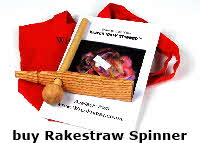Portable plying techniques for your Rakestraw spinner singles
If you are using a Rakestraw spinner or a drop spindle, it makes sense to use a plying method that is just as portable. Here are three techniques that you can try.
a) Andean plying
b) Plying over balls
c) Use the singles
d) Back to the Rakestraw Spinner (opens new page)
A) Andean plying
Andean plying using just your hands is a widely used method. Some people prefer using a specially made Andean Plying Paddle rather than their hands, to avoid one of the fingers turning blue if the wool is wound too tightly. I prefer to use my hands rather than having to carry another tool. I was happy using Andean plying when I was a beginning spinner, as I was using shorter lengths of thicker singles. As my spinning improved and the singles became finer I started to dislike Andean plying. No matter how careful I was, the singles became tangled half way through my plying and I ended up wasting a lot of yarn.
B) Plying on felt balls
I first heard about this alternative plying technique in Abby Franquemont’s ‘Respect the Spindle’. When you read through these instructions, the method may seem a little time-consuming. It does not take long, however, and you save a great deal of time by not having to deal with tangles. Unlike Andean plying, this method does not require much concentration and you can do it whilst talking with friends or travelling.
 You will need either You will need either
- three small felt balls (my favourite) or
- three hazelnuts or walnuts in their shells or
- three pompoms
1. Spin a Rakestraw spinner full of singles.
2. Wind the singles round your chosen ball, as if you were winding a ball of string.
3. Spin a second Rakestraw spinner full of singles.
4. Wind the singles round another ball.
5. Now hold the start of the singles from the first ball together with the start of the singles from the second ball and wind them together round a third ball
6. You can now ply directly from the third ball. Some people prefer to place the ball under an upside down plant pot and thread the double yarns through the hole. I just keep the ball inside a cloth bag beside me.
7. You will probably find this to be the easiest and most portable plying method there is.
C) Use the singles
Another alternative is not to ply at all but use your spinning as singles. I find I use singles more and more.
1) First make a skein with the singles and put six ties, they will be all cork screwed, but that is OK.
2) Then stabilise the singles by slightly felting them (of course this will not work with superwash wool). First soak them in cold water, then put them in a bowl of warm water and agitate them by hand. Repeat this with the cold and warm water until you are happy with the results. Hang the skein to dry. Do not be tempted to felt the singles in the washing machine, as they will all stick together in a terrible mess.
3) You can use these singles in coiled baskets, tapestry, couched embroidery and even knitting.
Top of page
|

